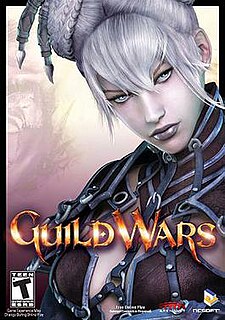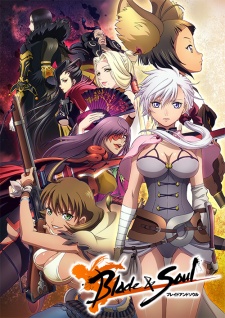
Lineage is a medieval fantasy, massively multiplayer online role-playing game (MMORPG) released in Korea and the United States in 1998 by the South Korean computer game developer NCSoft, based on a Korean comic book series of the same name. It is the first game in the Lineage series. It is most popular in Korea and is available in Chinese, Japanese, and English language versions. The game was designed by Jake Song, who had previously designed Nexus: The Kingdom of the Winds, another MMORPG.

NCSoft Corporation is a South Korean video game developer and publisher headquartered in Pangyo, Seongnam, South Korea, primarily known for the distribution of massively multiplayer online role-playing games such as Lineage and Guild Wars.

City of Heroes (CoH) was a massively multiplayer online role-playing game which was developed by Cryptic Studios and published by NCSOFT. The game was launched in North America on April 28, 2004, and in Europe by NCsoft Europe on February 4, 2005, with English, German and French servers. In the game, players created super-powered player characters that could team up with others to complete missions and fight criminals belonging to various gangs and organizations in the fictional Paragon City.
Guild Wars is an online role-playing game franchise developed by ArenaNet and published by NCSOFT. The games were critically well received and won many editor's choice awards, as well as awards such as Best Value, Best Massively Multiplayer Online Role-Playing Game (MMORPG), and Best Game. Guild Wars was noted for being the "first major MMO to adopt a business model not based on monthly subscription fees", its instanced approach to gameplay, and the quality of the graphics and play for computers with low specifications. In April 2009, NCSoft announced that 6 million units of games in the Guild Wars series had been sold. The sequel and fourth major entry into the series, Guild Wars 2, was announced in March 2007 and released on August 28, 2012. It features updated graphics and gameplay mechanics, and continues the original Guild Wars tradition of no subscription fees. The Guild Wars series had sold 11.5 million copies by August 2015

Lineage II is a massively multiplayer online role-playing game (MMORPG) for Microsoft Windows and the second game in the Lineage series. It is a prequel to Lineage and is set 150 years before the first game. It has become popular since its October 1, 2003 launch in South Korea, reporting 1,000,918 unique users during the month of March 2007. To date, the game has been played by more than 14 million users, most of whom are based in Asia.

Richard Garriott's Tabula Rasa is a defunct MMORPG developed by Destination Games and published by NCsoft, designed in part by some including Richard Garriott. The game is a role-playing video game that blends certain shooter aspects into the combat system. It was officially released to retail on November 2, 2007, with customers that pre-ordered the game allowed access to the live servers from October 30, 2007. The development team released updates, called "Deployments," nearly every month following launch. The game required a monthly subscription.

Auto Assault was a massively multiplayer online game, developed by NetDevil and published by NCSOFT. It combined vehicular combat with role-playing elements, allowing the player to explore a post-apocalyptic future in customizable cars, motorcycles, semis, and tanks. It took inspiration, in part, from the Mad Max series of films.
Dungeon Runners was a medieval fantasy, often satirical MMORPG developed and published by NCSOFT. It featured gameplay similar to the Diablo series of games.

Aion: The Tower of Eternity is a massively multiplayer online role-playing game (MMORPG) developed and published by the South Korean company NCSoft. The game combines PvP and PvE in a fantasy game environment. As of May 20, 2009, Aion had 3.5 million subscribers in Asia. AION's first major expansion pack was released to North America and Europe on September 7, 2010 under the name AION: Assault on Balaurea. Truly Free launched on April 11, 2012 with no restrictions. Aion's second major expansion was released in North America on June 26, 2013 under the name "Aion: Dark Betrayal". Its most recent expansion was launched on July 13, 2016 under the name "Aion: Echoes of Eternity".

Guild Wars is a multiplayer online action role-playing game developed by ArenaNet, a subsidiary of South Korean game publisher NCSOFT, and released in 2005. As the original installment of the Guild Wars series, its campaign was retroactively titled Prophecies to differentiate it from the content of subsequent releases. The game contains a co-operative role-playing portion and a competitive Player versus Player (PvP) portion. In PvP, players may use either their co-operative characters or PvP-exclusive characters who are inherently maximum level and have account-based access to unlocked content.

Guild Wars 2 is a free-to-play, massively multiplayer online role-playing game developed by ArenaNet and published by NCSoft. Set in the fantasy world of Tyria, the core game follows the re-emergence of Destiny's Edge, a disbanded guild dedicated to fighting Elder Dragons, colossal Lovecraftian-esque entities that have seized control of Tyria in the time since the original Guild Wars (2005), a plot line that was concluded in the latest expansion End of Dragons (2022). The game takes place in a persistent world with a story that progresses in instanced environments.
The history of massively multiplayer online games spans over thirty years and hundreds of massively multiplayer online games (MMOG) titles. The origin and influence on MMO games stems from MUDs, Dungeons & Dragons (D&D) and earlier social games.

Mortal Online is a first-person, open-world, PvP/PvE sandbox MMORPG developed and published by the Swedish independent video game company Star Vault. Mortal Online was released on June 9, 2010. The game is inspired by the desire to return to Ultima Online's player-controlled, sandbox-style game design; it uses Epic Games' Unreal Engine 3 and features a skill-based, real-time combat system.

Blade & Soul is a Korean fantasy martial-arts massively multiplayer online role-playing game developed by NCSoft. Blade & Soul was released in Western territories on January 19, 2016. A Japanese animated television adaptation aired on April 3, 2014, on TBS and other stations then finished on June 26.

TERA, also known as TERA Online, was a massively multiplayer online role-playing game (MMORPG) developed by Bluehole Studio, a subsidiary of Krafton. The game was released in South Korea on 25 January 2011, in North America on 1 May 2012, and in Europe on 3 May 2012, with closed and open beta tests taking place before the launch dates. Nexon, Krafton, and Gameforge published the game in these regions, respectively. En Masse Entertainment was the North American publisher, until September 2020, while Atari handled physical distribution. In February 2013 the game was renamed to TERA: Rising concurrently with the game's launch to the free-to-play model.

Star Legends: The Blackstar Chronicles is a 3D mobile MMO by Spacetime Studios, creators of the popular iOS & Android app: Pocket Legends.

Wizardry Online was a free-to-play MMORPG developed by Gamepot, Inc, based on the classic Wizardry computer games originally created by Sir-Tech. It was released in January 2013 before being discontinued in July 2014.
Darkfall Unholy Wars was a massively multiplayer online role-playing game developed by Aventurine SA. It was announced on 18 September and is a sequel to Darkfall. It is a PvP MMORPG where players are encouraged to form clans and battle for dominance across Agon, the fantasy world in which the game takes place.

Carbine Studios was a video game developer and subsidiary of NCSOFT, founded in 2005 by former members of Blizzard Entertainment. They were the developers of the online role-playing game WildStar.

Master X Master (MXM) was a multiplayer online battle arena (MOBA) video game developed and published by NCsoft.

















